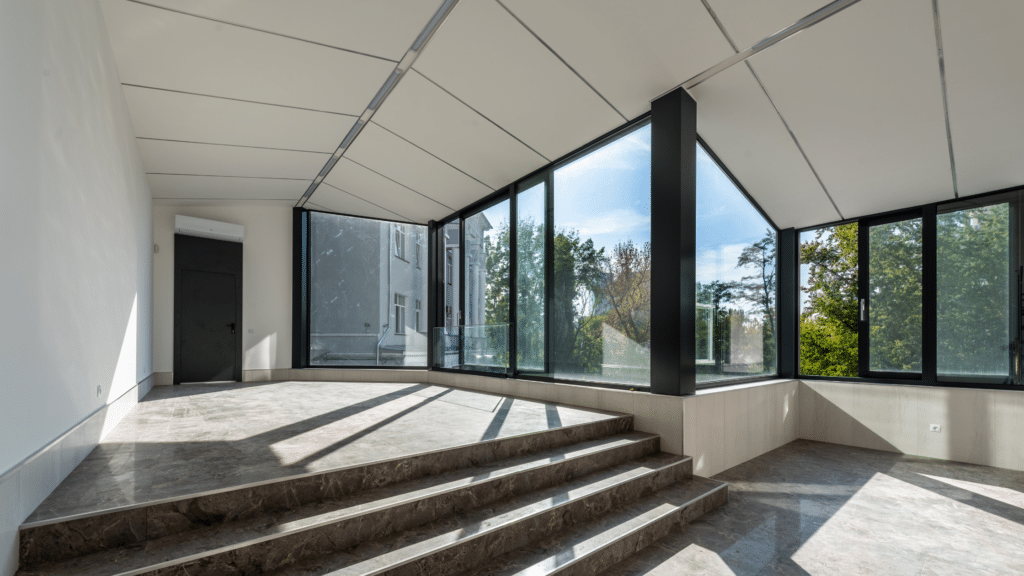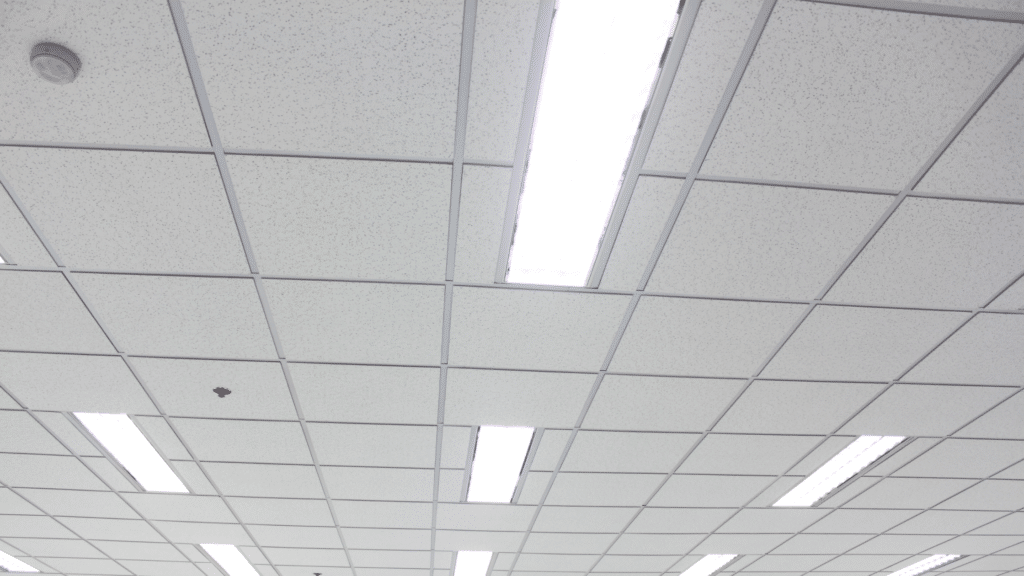Acoustic ceiling tiles are a must-have for anyone looking to improve the acoustics of their space. These ceiling products are made from materials that absorb sound waves, reducing the noise that bounces off walls and ceilings. In an office, school, or home setting, acoustic ceiling tiles can make a much more comfortable environment.
One famous brand of acoustic ceiling tiles is Armstrong ceiling tiles. They come in various styles, including plain and textured options. Installing these tiles can help create a more productive environment by reducing noise levels and improving sound quality.
In addition to Armstrong ceiling tiles, many other types of acoustic ceilings are available on the market. These include fiberglass panels, mineral fiber panels, and perforated metal panels. Each type of acoustic ceiling has its unique benefits and drawbacks.
Fiberglass panels are lightweight and easy to install but may not be as durable as other options. Mineral fiber panels are more robust than fiberglass but can be challenging to clean due to their porous nature. Perforated metal panels offer excellent durability but may not provide as much sound absorption as other options.
When choosing an acoustic ceiling tile product, it’s essential to consider your specific needs carefully. Factors such as room size, intended use of the space, and budget should all play a role in your decision-making process.
One famous brand of acoustic ceiling tiles is Armstrong ceiling tiles. They come in various styles, including plain and textured options. Installing these tiles can help create a more productive environment by reducing noise levels and improving sound quality.
In addition to Armstrong ceiling tiles, many other types of acoustic ceilings are available on the market. These include fiberglass panels, mineral fiber panels, and perforated metal panels. Each type of acoustic ceiling has its unique benefits and drawbacks.
Fiberglass panels are lightweight and easy to install but may not be as durable as other options. Mineral fiber panels are more robust than fiberglass but can be challenging to clean due to their porous nature. Perforated metal panels offer excellent durability but may not provide as much sound absorption as other options.
When choosing an acoustic ceiling tile product, it’s essential to consider your specific needs carefully. Factors such as room size, intended use of the space, and budget should all play a role in your decision-making process.
And if you are looking for a cost, then you will want to check out this calculator.

Benefits of Using Acoustic Ceiling Tiles
Improved Speech Intelligibility and Reduced Echoes
Acoustic ceiling tiles are specifically designed to absorb sound, reducing noise levels in a room. This feature makes them an excellent choice for spaces that require clear communication, such as classrooms, conference rooms, and offices. Auditing sound waves allows acoustic ceiling tiles to improve speech intelligibility and reduce echoes. This means that people can communicate more effectively in the space without raising their voices or repeating themselves.
Reduced Noise Pollution
One of the most significant benefits of using acoustic ceiling tiles is that they can create a more comfortable environment by reducing the amount of noise pollution. In today’s world, noise pollution has become a significant problem in many urban areas. It can cause stress, fatigue, and even hearing loss over time. Acoustic ceiling tiles provide an effective solution to this problem by absorbing sound waves before they have a chance to bounce around the room.
Increased Productivity
Noise pollution can distract and disrupt work environments like offices and schools. It can make it difficult for people to concentrate on their tasks or studies, leading to decreased productivity. Installing acoustic ceiling tiles is an effective way to reduce distractions and increase focus in these spaces. Employees or students can concentrate better on their work or studies by creating a quieter environment.
Customizable Options
Acoustic ceiling tiles are available in various materials and designs that allow customization based on specific needs and aesthetics. Some options include fiberglass panels with vinyl facing or mineral fiber panels with painted finishes. There are different sizes available depending on the size of your space.
Cost-Effective Solution
Compared to other soundproofing options like wall insulation or double-glazed windows, installing acoustic ceiling tiles is a cost-effective solution for improving acoustics in a space. The installation process is relatively easy compared to other soundproofing methods requiring professional help.

Types of Acoustic Ceiling Tiles and Panels
Fiberglass Acoustic Panels
Fiberglass acoustic panels are among the most popular acoustic panels in the market. These panels are made from glass fibers woven together to create a mat. The mat is then compressed and heated to form a panel. Fiberglass acoustic panels are known for their excellent sound absorption properties and can be used in various applications.
One of the main advantages of fiberglass acoustic panels is that they are lightweight and easy to install. They can be easily cut to size and shape, making them ideal for custom installations. Fiberglass acoustic panels are available in various colors and finishes, allowing them to blend seamlessly into any interior design.
However, it’s important to note that fiberglass acoustic panels can be hazardous if not handled properly. The glass fibers can cause skin irritation and respiratory problems if they come into contact with your skin or lungs. Therefore, it’s essential to wear protective clothing when handling these panels.
Mineral Fiber Acoustic Panels
Mineral fiber acoustic panels are another popular acoustic panel type commonly used in commercial buildings. These panels are made from mineral wool fibers, which are compressed and formed into a panel using heat and pressure.
One of the main advantages of mineral fiber acoustic panels is their high fire resistance rating. This makes them an ideal choice for buildings where fire safety is a concern. Mineral fiber acoustic panels have excellent sound absorption properties and can help reduce noise levels in large open spaces.
However, like fiberglass acoustic panels, mineral fiber acoustic panels can be hazardous if improperly handled. The mineral wool fibers can cause skin irritation and respiratory problems if they come into contact with your skin or lungs.
Metal Acoustic Panels
Metal acoustic panels are a relatively new addition to the market but have quickly gained popularity due to their unique aesthetic appeal. These panels are made from perforated metal sheets that allow sound waves to pass through while reflecting them into the room.
One of the main advantages of metal acoustic panels is their durability. They are resistant to scratches, dents, and other forms of damage, making them ideal for high-traffic areas. Metal acoustic panels are available in various colors and finishes, allowing them to blend seamlessly into any interior design.
However, it’s important to note that metal acoustic panels can be expensive compared to other acoustic panels. They may not provide as much sound absorption as other acoustic panels.
Wood Acoustic Panels
Wood acoustic panels are a popular choice for buildings where aesthetics are a concern. These panels are made from natural wood fibers and come in various finishes and stains.
One of the main advantages of wood acoustic panels is their ability to blend seamlessly into any interior design. They can be stained or painted to match existing woodwork or furniture, creating a cohesive look. Wood acoustic panels have excellent sound absorption properties and can help reduce noise levels in large open spaces.
However, it’s important to note that wood acoustic panels can be expensive compared to other acoustic panels. They may not provide as much sound absorption as other acoustic panels.
Fabric-Wrapped Acoustic Panels
Fabric-wrapped acoustic panels are another popular type of acoustic panel commonly used in commercial buildings. These panels consist of a fiberglass core wrapped in an acoustically transparent fabric.
One of the main advantages of fabric-wrapped acoustic panels is their aesthetic appeal. The fabric covering allows them to blend seamlessly into any interior design while providing excellent sound absorption properties. Fabric-wrapped acoustic panels are available in various colors and finishes, allowing them to match any decor.
However, it’s important to note that fabric-wrapped acoustic panels can be challenging to clean if they become soiled or stained. The fabric covering may wear over time, reducing the effectiveness of the sound absorption properties.
Coffered, Crisscross, and Domed Baffle Grids for Acoustic Ceiling Tiles
Coffered, crisscross, and domed baffle grids are popular suspended ceiling grid options for acoustic ceiling tiles. These grids hold tiles securely in place and provide a visually appealing look to the ceiling. In this section, we will discuss each of these grid types in detail.
Coffered Grids
Coffered grids are suspended ceiling grids that create a series of recessed panels in the ceiling. These panels can be square or rectangular and are often used to create an elegant and sophisticated look in commercial spaces such as offices, hotels, and restaurants.
One of the benefits of coffered grids is their ability to reduce noise levels in large rooms by blocking sound from traveling across the open space above the tiles. This makes them an excellent choice for spaces where privacy is essential.
Crisscross Grids
Crisscross grids are another popular option for suspended ceilings. As their name suggests, they feature a crisscross pattern that creates a unique visual effect on the ceiling.
Crisscross grids work well in spaces where you want to add interest or texture to an otherwise plain ceiling. They’re also great at reducing noise levels by blocking sound waves from traveling across open spaces above the tiles.
Domed Baffle Grids
Domed baffle grids with curved baffles help diffuse sound waves and reduce noise levels in large spaces. They are often used in areas such as auditoriums, concert halls, and conference rooms where sound quality is critical.
These types of grids provide a unique look to the ceiling while also offering excellent acoustic performance.

Hexagon and Sculptural Designs for Acoustic Ceiling Panels
La Maison Ceilings is one company leading the way in hexagon and sculptural designs for acoustic ceiling panels. These designs look beautiful and offer high-performance noise reduction thanks to materials like fiberglass, foam, and stone wool fiber.
In addition to their acoustic properties, these panels are also incredibly versatile when it comes to design. They can be used as standalone pieces or combined with wood or metal for a more industrial look.
Choosing the Right Acoustic Ceiling Solution for Your Project
Consider the Project Details and Requirements
Choosing the right acoustic ceiling solution for your project is essential to ensure optimal acoustic performance. Considering the project details and requirements before selecting a solution is essential. There are more options for acoustic ceiling tiles, including different materials, sizes, and designs. Therefore, choosing a solution that fits your budget is crucial.
When selecting an acoustic ceiling tile, you should consider the size of the room, the purpose of the space, and any other factors that may impact acoustics. For example, if you’re designing a music studio or home theater room where sound quality is critical, you’ll need a high-performance acoustic ceiling tile that can absorb sound waves effectively.
On the other hand, if you’re designing an office space or classroom where speech intelligibility is essential, you’ll need an acoustic ceiling tile with good sound attenuation properties. By considering these factors carefully, you can select an appropriate solution that meets your needs and delivers excellent results.
Lay Tiles Properly to Prevent Breakage
Once you’ve selected your preferred acoustic ceiling tile solution for your project title details and budget constraints, it’s time to lay them properly. Laying tiles correctly will help prevent breakage and ensure optimal acoustic performance.
Before laying tiles on the ceiling surface, make sure it’s clean and free from any debris or dust particles that could affect adhesion. You should also measure the area accurately to determine how many tiles you’ll need for complete coverage.
When laying tiles in place on the ceiling surface be careful not to apply too much pressure as this could cause them to break or crack under stress. Instead use gentle but firm pressure when placing each tile in its designated location until all tiles are installed correctly.
View Case Studies Before Making Your Decision
If you’re still unsure which type of acoustic ceiling tile would be best for your project title details or small business needs view case studies before making a decision. Case studies provide an excellent way to see how different solutions have performed in real-world situations.
You can learn about the benefits and drawbacks of various acoustic ceiling tile solutions by reviewing case studies. You can also see how other small businesses have used these products to improve their acoustics and create a more comfortable environment for employees or customers.
More Buying Options with Free Delivery May Be Available
When selecting an acoustic ceiling tile solution, it’s important to consider your budget constraints. Fortunately, there are many options available that offer excellent value for money without compromising on quality.
If you’re looking for more buying options, check out online retailers that offer free delivery may be available. This could help you save money on shipping costs while still getting the best possible product for your project title details and small business needs.
But the best option by far is to have a contractor assist and install them for you. This route also saves you time worrying about what should be done.
Commitment to Quality and Customer Satisfaction
Finally, when choosing an acoustic ceiling tile solution, select a supplier committed to quality and customer satisfaction. Look for suppliers who offer warranties on their products and have a reputation for providing excellent customer service.
By working with a reputable supplier, you can get the best possible product at a fair price. You’ll also have peace of mind knowing that if anything goes wrong with your acoustic ceiling tiles or installation process, they will help resolve any issues quickly and efficiently.

Tips for Designing with Acoustical Ceiling Panels for Your Project
Consider the size and shape of the room
When designing with acoustic ceiling panels, it is important to consider the size and shape of the room. The larger the space, the more sound-absorbing material is needed to achieve optimal acoustic performance. Irregularly shaped rooms may require special attention to absorb sound waves adequately.
Choose panels with a high NRC
The noise reduction coefficient (NRC) measures how much sound a material can absorb. When selecting acoustic ceiling panels, it is vital to choose those with a high NRC for spaces with high levels of noise. For example, choosing panels with an NRC of .80 or higher in a busy restaurant or office building can significantly reduce noise levels and improve overall acoustics.
Use different colors or patterns
Acoustic ceiling panels don’t have to be boring! Using different colors or patterns can create visual interest and enhance the space’s overall design. For example, in a classroom setting, using brightly colored panels can help create a fun and engaging learning environment.
Install acoustic ceiling panels strategically
Installing acoustic ceiling panels strategically is critical to achieving optimal acoustic performance. Panels should be installed in areas where sound reflection is most problematic. This might include above workstations in an open office environment or above dining tables in a restaurant.
Consult with an acoustics professional
While these tips help you design acoustic ceiling panels independently, consulting with an acoustics professional can ensure you achieve the best acoustic performance for your project. They can recommend specific products based on your needs and guide installation techniques.
Key Points about Acoustic Ceiling Tiles
Different Sizes and Shapes
Acoustic ceiling tiles come in different sizes and shapes, but the most common ones are 2′ x 2′ or 2′ x 4′. These tiles can be easily cut to fit any space, making them versatile for various room sizes. Whether you have a small conference room or a large auditorium, acoustic ceiling tiles can help improve the sound quality of your space.
The size and shape of the tiles you choose will depend on several factors such as the height of your ceiling, the size of your room, and your personal preferences. If you have a high ceiling, larger tiles may be more appropriate to cover more surface area. On the other hand, if you have a smaller room, smaller tiles may be better suited to create a more proportional look.
Absorption of Sound Waves
One of the primary benefits of acoustic ceiling tiles is their ability to absorb sound waves. When sound waves bounce off hard surfaces like walls and ceilings, they create echoes that can make it difficult to hear speech clearly or enjoy music. Acoustic ceiling tiles are designed to reduce these echoes by absorbing sound waves instead of reflecting them.
These tiles are typically made from mineral fiber or fiberglass, making them lightweight and easy to install. The porous nature of these materials allows them to trap sound waves inside their fibers instead of bouncing them back into the room. As a result, installing acoustic ceiling tiles can significantly improve speech intelligibility and overall acoustics in any space.
Variety of Colors
Acoustic ceiling tiles come in various colors, but white is the most popular choice. White reflects light and creates a brighter space, making rooms feel larger and more inviting. However, if you want to add some color or personality to your space, many other options are also available.
You can choose from shades of gray or beige for a more neutral look that complements any decor style. Alternatively, you can opt for more vibrant colors like blue or green to add a pop of color and create a more playful atmosphere. Whatever your preference, there is an acoustic ceiling tile color that will suit your needs.
Cost-Effective Solution
Installing acoustic ceiling tiles is a cost-effective way to improve the sound quality of any room. These tiles are relatively inexpensive compared to other soundproofing solutions, such as installing new walls or adding insulation. They can be laid directly onto an existing ceiling without additional support, making them easy to install and saving on installation costs.
Moreover, acoustic ceiling tiles can help reduce energy costs by improving the overall acoustics of a space. When sound waves are absorbed instead of reflected, less energy is required to maintain comfortable noise levels in a room. This means that you can save money on heating and cooling costs while enjoying better sound quality at the same time.
Acoustic ceiling tiles offer numerous benefits, including noise reduction, improved speech intelligibility, and enhanced aesthetics. They can also help to improve indoor air quality by reducing the amount of dust and other airborne particles.
Many different types of acoustic ceiling tiles and panels are available on the market today. Some popular options include fiberglass, mineral wool, metal, wood fiber, and PVC.
Popular designs for acoustic ceiling panels include coffered, crisscross, domed baffle grids, hexagon shapes, and sculptural designs.
When choosing an acoustic ceiling solution for your project, it's essential to consider factors such as sound absorption performance, aesthetic appeal, ease of installation, and maintenance requirements.
Yes! Acoustic ceiling panels can be combined with other materials such as aluminum panels to create unique design solutions that meet specific project needs.
Yes! Some tips for designing acoustic ceiling panels include selecting the suitable panel material based on your desired performance characteristics and aesthetic preferences, considering lighting options that will enhance the look of your space, and working with a professional contractor who has experience installing these types of systems.

